The most gigantic star in the universe. Stars of the Universe
Have you ever tried to imagine something really big? Something so huge that it is even difficult to imagine? When it comes to size, nothing compares to the scale of space objects. So the size of our Sun is hundreds of times greater than the size of all the planets in its system combined! But, even despite such unimaginable sizes, they pale in comparison to the scale of the largest stars in the universe.
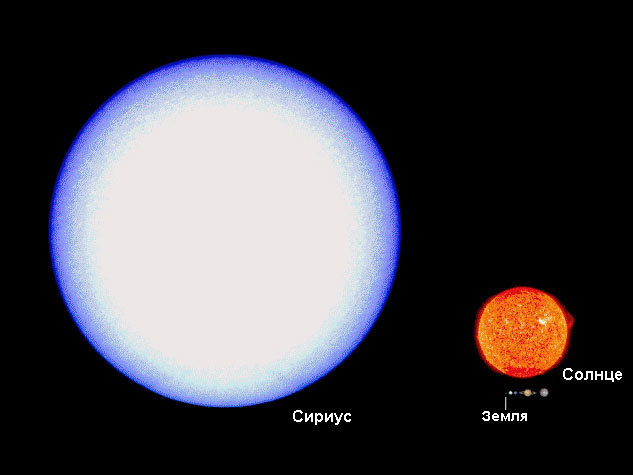
Sirius- one of the brightest objects in the night sky located in the constellation Canis Major. This star can be seen from almost any part of the planet, not taking into account its northernmost corners. Sirius is eight and a half light years away from the solar system and is one of the closest stars to us.
Initially, Sirius consisted of two powerful stars of spectral class A, which were called Sirius A and Sirius B. The mass of the first star was equal to two solar masses, the second was equal to five solar masses. Over time, the more massive object Sirius B burned up and became a white dwarf. Its discovery in 1915 was the first among “white dwarfs”. Currently, Sirius is a double star consisting of a white dwarf (Sirius B) and a star of spectral class A (Sirius A). According to rough estimates, Sirius A is twice the solar mass, Sirius B, on the contrary, remains slightly lighter than the Sun.
Modern research has shown that Sirius is approximately 200-300 million years old. In addition, the star’s brilliance increases over time, as it moves towards our Solar System at a speed of 7.6 km/s.
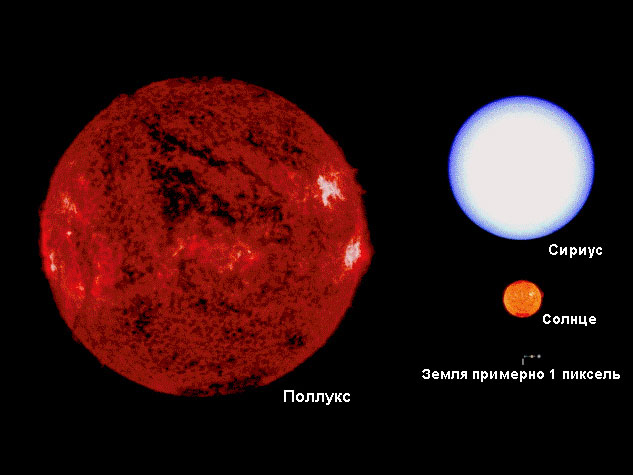
Pollux- orange giant, the most bright Star constellation Gemini and one of the brightest stars in the night sky.
In the depths of the star there is a huge reserve of helium, which will last for the next 100 million years, after which it will lose its gas envelope and become a dim white dwarf.
There is very little information about Pollux. Astronomers believe that this is variable star with brightness fluctuations of 1.10-1.17m.
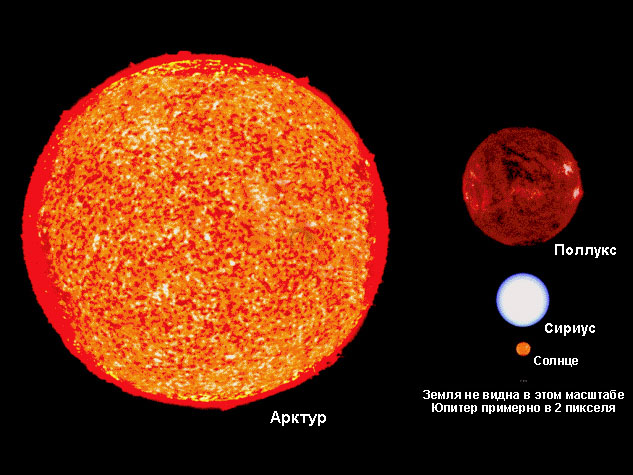
Arcturus- a red giant, the brightest star located in the constellation Bootes and the fourth brightest after the stars Canopus, Sirius and the Alpha Centauri system. Due to its northern declination, it is visible from almost anywhere on the globe, with the exception of Antarctica.
Arcturus is 180 times brighter than the Sun and is thirty-six and a half light years away from Earth. Like most red giants, Arcturus is a variable star due to the pulsations of its stellar surface. The approximate mass of Arcturus is 1-1.5 solar. Arcturus moves in galactic space along with fifty-two similar stars.
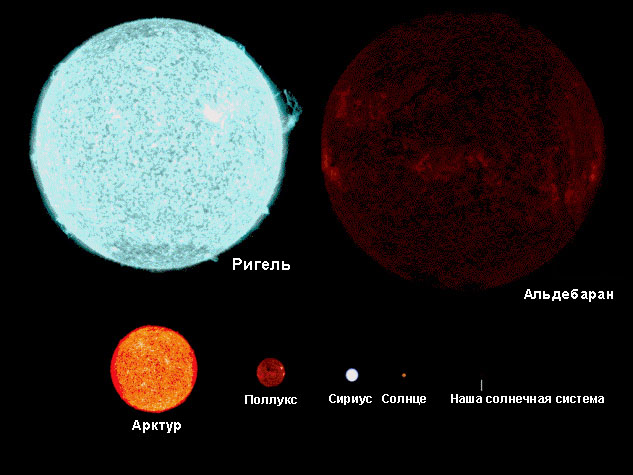
Rigel- a blue-white supergiant that is located at a distance of more than eight hundred light years from Earth. Its diameter is approximately 68 times that of the sun and is 95 million km. The star is seventeen times more massive and 85,000 times brighter than the Sun. The surface temperature is 11,200 K. Rigel is the closest star to us with such enormous luminosity and one of the most powerful stars in the Galaxy.
According to numerous measurements, the approximate distance to Rigel is from seven hundred to nine hundred light years. The radiation power of a star per square meter is 100 MW (approximately 10 kW/cm?). Any object located closer to Rigel than one astronomical unit (149,598,000 km) will evaporate and be scattered by a powerful stellar wind.
With its bright radiation, Rigel illuminates nearby dust clouds. One such cloud is the Witch's Head Nebula.
Aldebaran- an orange giant of spectral class K5 III and the brightest star in the constellation Taurus (Eye of Taurus). Due to its brightness, it is one of the most visible objects in the night sky.
According to the latest calculations by the European satellite Hipparcos, the distance from Aldebaran to Earth is approximately 65.1 light years. years. This is a variable star with an insignificant brightness amplitude and an irregular type of variability. Aldebaran's luminosity is 150 times greater than that of the Sun, which allows it to take 14th position in brightness among stellar giants. On this moment the size of the star is approximately 38 times the diameter of the Sun.
At a distance of several hundred a. That is, from Aldebaran there is a dim red dwarf that belongs to the M2 class and is its companion star. Launched in 1972 unmanned vehicle Pioneer 10, whose main goal was to explore Jupiter, is heading towards Aldebaran. Since 1983, it has been outside the Solar System, and if nothing interferes with it along the way, then in 2 million years it will reach the region of the star.
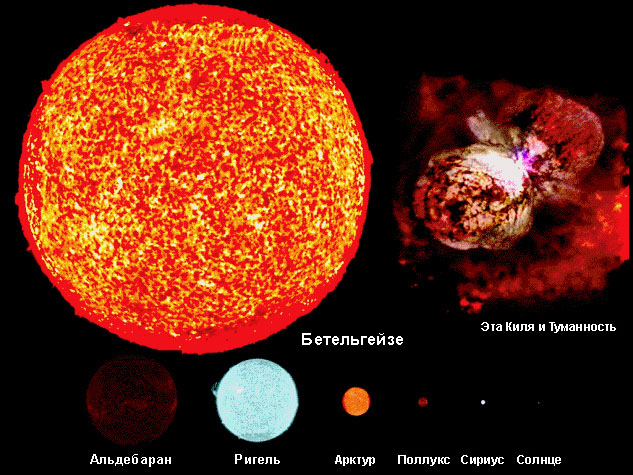
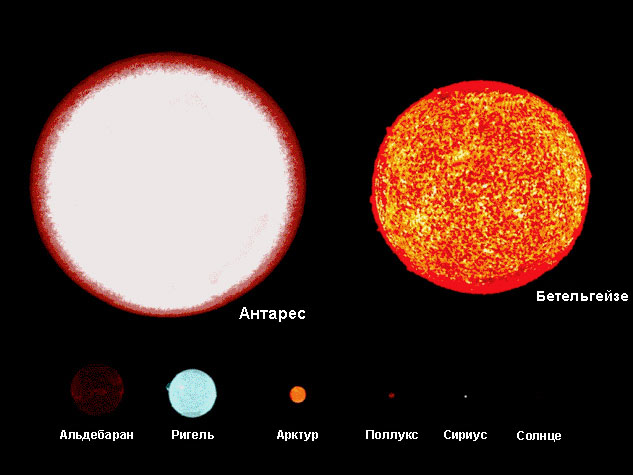
Antares is a red M-class supergiant, the brightest star in the constellation Scorpio. It is located in a region called Bubble I, which is adjacent to the Local Bubble, which includes our Solar System. The approximate distance from Earth to Antares is 600 sv. years. The diameter of the star is 2.1×109 km, and its luminosity is 10 thousand times higher than that of the sun. If we take into account the fact that the supergiant emits most of its energy in the infrared range, then its total luminosity is 65 thousand times greater than the Sun. Relative to its size, Antares has a fairly small mass, which equates to approximately 15-18 solar masses. This is explained by the very low density of the star.
At a distance of two point nine arc seconds from Antares, its companion star Antares B is located. It has a considerable size of fifth magnitude, but despite this, due to the brightness of the first, it is quite difficult to see it. The orbital period of Antares B around Antares A is 878 years.
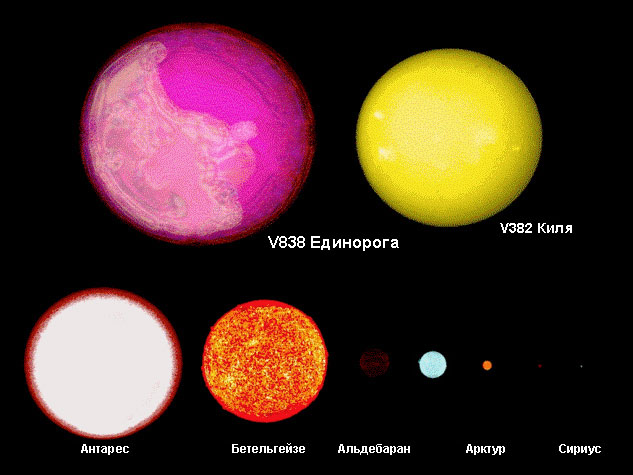
V838 Unicorn is a variable star located at a distance of approximately 20,000 light years. years from Earth in the constellation Monoceros. At the beginning of 2002, a serious explosion occurred on the star, the cause of which is still not clear. One of the main theories is that the flare is associated with the absorption of planets or a companion, as well as with the processes of the dying star.
V382 Kiel(x Car, x Carinae) is a yellow class G hypergiant in the constellation Carinae. The distance from the Sun is 5930.90 sv. years, and the apparent magnitude of the star is +3.93. V382 is a pulsating variable star (Cepheid), and varies in brightness ranging from +3.84 to +4.02.
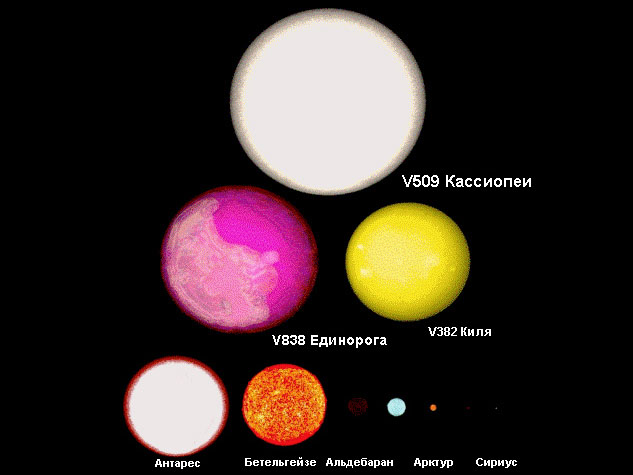
V509 Cassiopeia- a yellow-white G-class hypergiant located in the constellation Cassiopeia. It is classified as a semi-regular Cepheid star, with a brightness of +4.75m to +5.5. Distance from the Sun is more than 7800 sv. years.
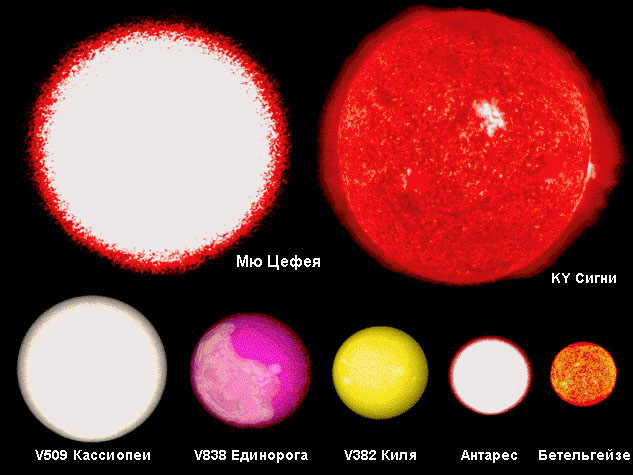
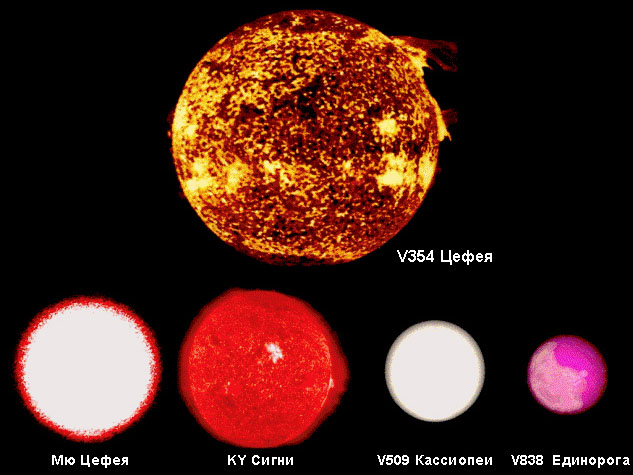
V354 Cephei is a red supergiant, irregular variable star in the Milky Way galaxy. The approximate radius of V354 is 1.06 billion km. (which is 1520 times larger than the sun), so it is rightfully considered one of the largest currently known cosmic bodies. If a star of this magnitude were placed in the place of our Sun, then its limits would be somewhere between Saturn and Jupiter. The distance from Earth to V354 Cepheus is approximately nine thousand light years.
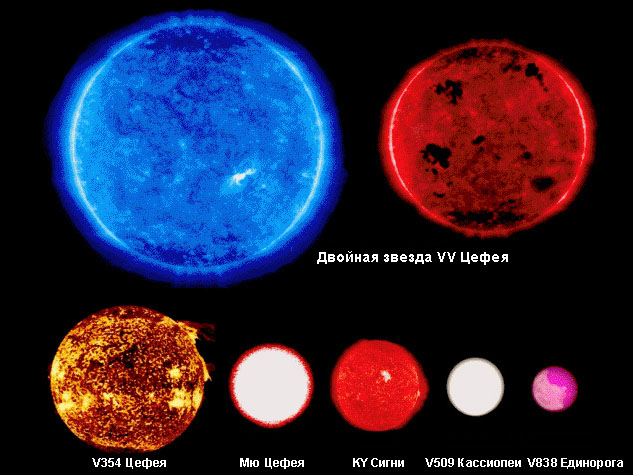
VV Cepheus- a double star located at a distance of approximately three thousand light years. years from the Sun in the constellation Cepheus. Component A of the VV star is the second most a big star the Milky Way galaxy and the third of the present known to man largest stars in the Universe.
VV Cephei A- a red supergiant of the M2 class, the luminosity of which is 275 - 575 thousand times greater than the brightness of the Sun. The second largest star in our Galaxy. Its diameter is over 2,644,800,000 km, which is approximately 1600-1900 times larger than the Sun. As a result of long-term studies, it was found that component A is a Cepheid with a period of one hundred and fifty days. The stellar wind that flows from VV Cepheus A reaches a speed of 25 kilometers per second. Despite its gigantic size, the mass of the star is relatively small and is equal to one hundred solar masses. However, some scientists, based on the luminosity of the supergiant, are inclined to believe that the mass of the star is no more than 25-40 solar masses.
VV Cephei B is a blue class B0 star that revolves around VV Cephei A in an elliptical orbit. The rotation period of component B around component A is 7430 days (approximately 20 years). The eclipse of stars by each other lasts 1300 days (3.6 years), the total eclipse phase lasts 480 days (1.3 years). After it was discovered in 1936 that VV Cephei was a binary eclipsing variable star, eclipses of the B component were observed at intervals of 20 years. The diameter of VV Cepheus B is almost ten times the diameter of the Sun, and its luminosity is 100,000 times that of the Sun. The approximate distance between the centers of stars varies from seventeen to thirty-four astronomical units.
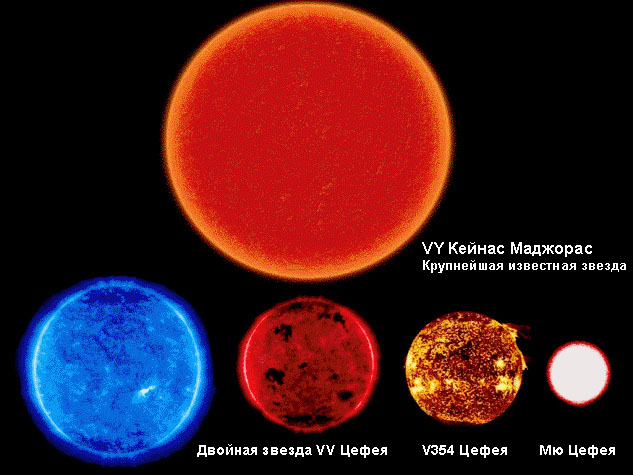
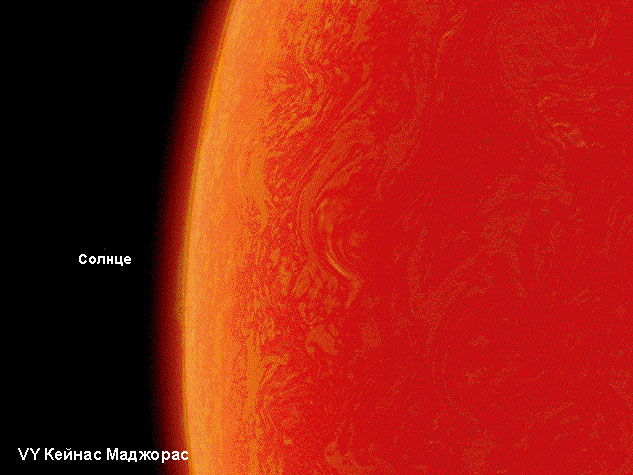
Video on topic
as well as many other sources, we get a very consistent picture of the Universe. It is composed of 68% dark energy, 27% dark matter, 4.9% ordinary matter, 0.1% neutrinos, 0.01% radiation and is about 13.8 billion years old. The uncertainty about the age of the Universe is around 100 million years, so while the Universe could certainly be a hundred million years younger or older, it is unlikely to reach 14.5 billion years.
ESA's Gaia mission measured the positions and properties of hundreds of millions of stars near the galactic center and found the oldest stars known to mankind.
This leaves only one reasonable possibility: we must be misestimating the ages of the stars. We have studied hundreds of millions of stars in detail at different stages of their lives. We know how stars form and under what conditions; we know when and how they ignite nuclear fusion; we know how long the various stages of synthesis last and how effective they are; we know how long they live and how they die, different types with different masses. In short, astronomy is a serious science, especially when it comes to stars. In general, the oldest stars are relatively low mass (less massive than our Sun), contain few metals (elements other than hydrogen and helium), and may be older than the galaxy itself.

Extremely old stars can be found in globular clusters
Many of them are in globular clusters, which, to be sure, contain stars 12 billion or, in rare cases, even 13 billion years old. A generation ago, people claimed that these clusters were 14-16 billion years old, straining established cosmological models, but gradually improving understanding of stellar evolution has brought these numbers into line with the norm. We have developed more advanced techniques to improve our observational abilities, by measuring not only the carbon, oxygen or iron content of these stars, but also by using the radioactive decay of uranium and thorium. We can directly determine the age of individual stars.

SDSS J102915+172927 is an ancient star 4,140 light years away that contains only 1/20,000th the heaviest elements of our Sun and should be 13 billion years old. This is one of the oldest stars in the Universe
In 2007, we were able to measure the star HE 1523-0901, which is 80% of the mass of the Sun, contains just 0.1% of solar iron, and is believed to be 13.2 billion years old based on its abundance of radioactive elements. In 2015, nine stars were identified near the center of the Milky Way that formed 13.5 billion years ago: just 300,000,000 years after the Big Bang. "These stars formed before the Milky Way and the galaxy formed around them," says Louis Howes, co-discoverer of these ancient relics. In fact, one of these nine stars has less than 0.001% solar iron; This is the type of star the James Webb Space Telescope will be looking for when it starts operating in October 2018.
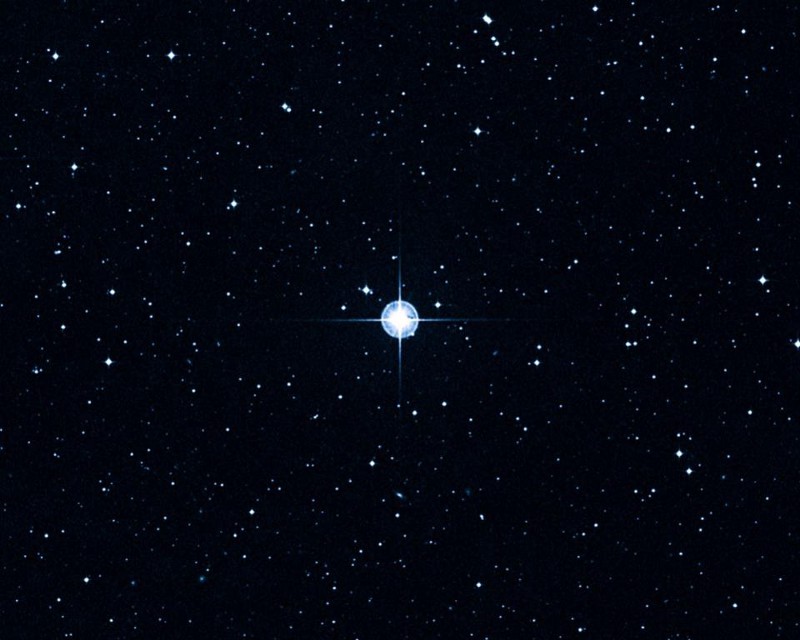
This is a digitized image of the old star in our galaxy. This aging starHD140283 is 190 light years away. The Hubble Space Telescope clarified its age at 14.5 billion plus or minus 800 million years
The most striking star of all is HD 140283, informally nicknamed the Star of Methuselah. It's only 190 light-years away, and we can measure its brightness, surface temperature, and composition; we can also see that it is just starting to develop into a subgiant phase to become a red giant. These pieces of information allow us to deduce a well-defined age for the star, and the result is worrying to say the least: 14.46 billion years. Some properties of the star, such as its iron content of 0.4% of the Sun, indicate that the star is old, but not the oldest of all. And despite the possible error of 800 million years, Methuselah still creates a certain conflict between the maximum age of stars and the age of the Universe.

The Milky Way has not changed for billions of years. But as stars grow older, the most massive ones cease to exist, and the least massive ones begin to turn into subgiants
Today it is obvious that something could have happened to this star in the past that we do not yet know today. Maybe she was born more massive and somehow lost her outer layers. Maybe the star absorbed some material later that changed its heavy element content, confusing our observations. It may be that we simply have a poor understanding of the subgiant phase in the stellar evolution of ancient low metallicity stars. Gradually we will derive the correct form or calculate the age of the oldest stars.
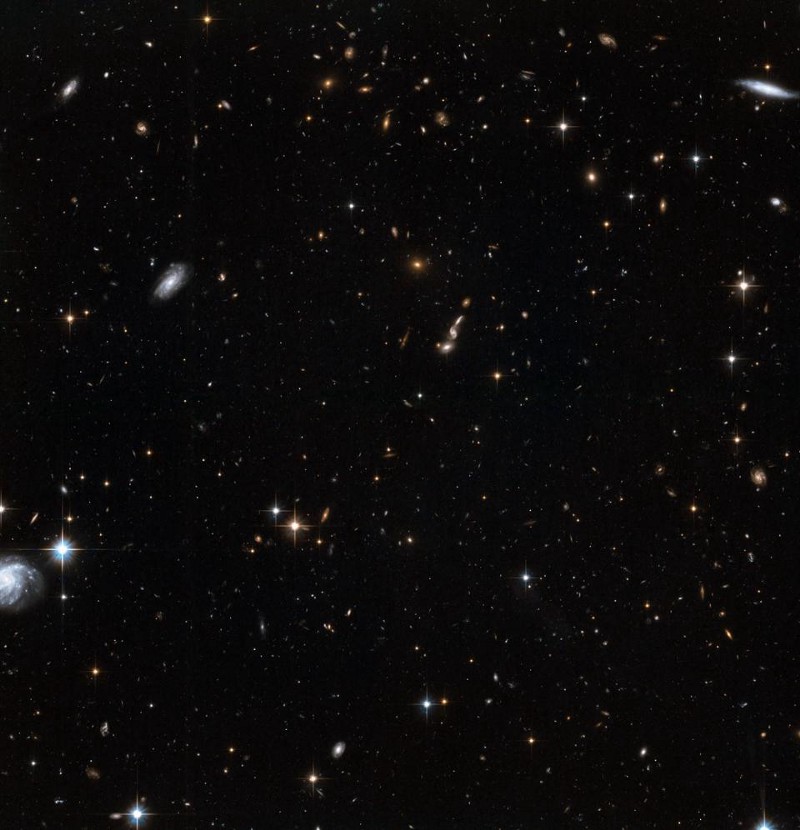
But if we are right, we face a serious problem. There cannot be a star in our Universe that is older than the Universe itself. Either there is something wrong with the estimate of the age of these stars, or something is wrong with the estimate of the age of the Universe. Or something else that we don’t understand at all yet. This is a great chance to move science in a new direction.
Astronomers are finding stars that are older than the Universe. How is this possible? Ilya Khel
In our Galaxy - Milky Way– several hundred billion stars different types, colors and calibers. Stars here are constantly formed from the Galaxy’s huge mineral reserves - oil and gas, that is, dust and gas, of course. Huge clouds drift in the galactic plane in a circle. They are crushed into sleeves by the gravity of the supermassive black hole at the galactic core. Whether a star explodes, a stellar association flies past a cloud, or tidal disturbances from some massive objects intervene, and - done! The cloud begins to shrink, shrink, the process accelerates over time, the atoms are already cramped, and the force inexorably continues to press and pull them towards the center, until the impacts of the atoms against each other cease to be elastic, and begin to tear off the electron shells, creating ions, and then, even cooler - hydrogen atoms will begin to fuse into helium, releasing energetic photons that carry energy into outer space.

Credit: Living Universe website
The dust cloud is suddenly pierced by a shock wave, throwing opposite directions streams of luminous material - Herbig's famous objects - Haro! Fierce rays will break through the dust, and the newborn star will begin its life. Its wind will eventually clear all the dust, all the light elements into space, leaving only larger stones, rocks and asteroids in orbit. For billions of years, this rocky chaos around the young star will jostle, swirl and gather dust until, finally, several planets with a solid surface form. Nodes of gas remaining within this dust can accumulate all the material within their reach, compacting and rotating. And here you are - a giant gas planet. Life is new solar system has begun!
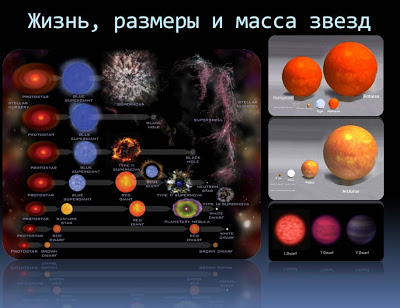
Credit: Living Universe website
But what's next for these stars? To answer this question, tell me what mass you are talking about! Unlike people, the fate of stars can be predicted with a good degree of confidence based on one (okay, two) of its properties. The first is the mass, the second is, of course, its spectral class.

Credit: Illustration: NASA/CXC/M.Weiss; X-ray: NASA/CXC/UC Berkeley/N.Smith et al.; IR: Lick/UC Berkeley/J.Bloom & C.Hansen
The most massive stars are blue supergiants, true megastars with masses between 140 and 280 solar masses, so hot inside (billions of degrees!) that the thermal energy inside begins to transform into electron-positron pairs, which violently annihilate in a process called “pair instability.” This is one of the most exotic cases in the part of the Universe we observe, since pair instability produces a supernova explosion of such force that it can be seen from the other end of the Universe, and after it there is practically nothing left - not a star, not a firebrand... So far we know about the existence of one such monster called SN 2006gy. It’s hard to imagine him, it’s scary to write about him...

Credit: X-ray: NASA/CXC/GSFC/M.Corcoran et al.; Optical: NASA/STScI
Blue supergiants live for a short time, tens, or at most hundreds of millions of years. Good example such a star is Eta Carinae. They embody the principle - Live fast (and bright), die young! During their lives, they fry the entire space around them with harsh ultraviolet radiation, losing a huge amount of material, sparing neither themselves nor others. Their life, as a rule, ends in a catastrophe - a type II supernova explosion, illuminating the entire Galaxy, which is visible for megaparsecs, from other galaxies, from other galaxy clusters!
The contents of the star - all the new heavy elements synthesized by it during its life - are turned outward, so that later, perhaps, they can form new planets, become amino acids, run as red blood cells in the blood of exotic aliens.
Stars of more moderate mass (like the Sun) live tens of billions of years relatively calmly, but at the end of their lives they begin to swell into red giants and supergiants. What else do they have left? All the nuclear fuel has been burned out, the core has shrunk to an enormous temperature in order to somehow prolong the fading life of the star, and there is nothing to hold the outer layers, their gas expands, cools and, naturally, turns red.
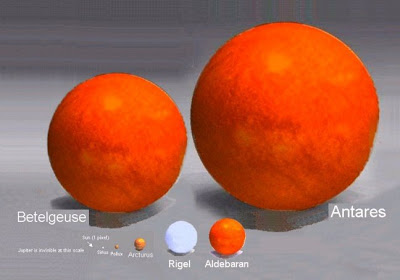
Some stars still find the strength to ignite the helium inside the core and begin to synthesize carbon. Some then manage to repeat the synthesis cycle with carbon. Each subsequent synthesis requires an increasingly higher temperature and degree of compression and lasts much shorter than the previous one. Finally, the star has exhausted all its reserves, and this means its end. The outer layers are shed into space, becoming a slowly expanding planetary nebula, inside of which there is a hot core, whose stellar wind can sometimes collide in different combinations with the material of the nebula and form such bizarre shapes as those of the Cat's Eye Nebula or.

But the most common stars in the Galaxy are not blue giants or yellow Main Sequence stars. These are red and brown dwarfs - almost established and completely unfulfilled stars. Well, let's try to deal with them.
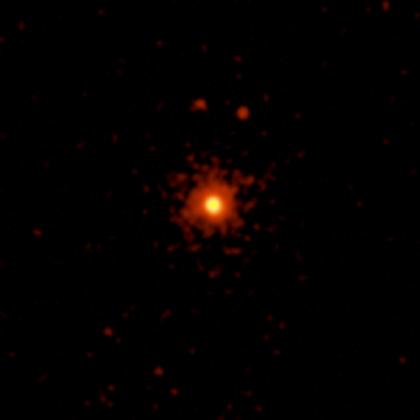
Credit: NASA/CXC/SAO
The mass of red dwarfs is from 8 to 50% of the mass of the Sun. Due to such a small mass, the process of helium synthesis in their core can take 20 billion years - this is more than the age of the Universe! The atmosphere of red dwarfs is very turbulent, they create violent magnetic fields around themselves, which is accompanied by photospheric flares and variable brightness, especially in the X-ray range. A good example of a red dwarf is Proxima (Nearest) Centauri. After a long, long smoldering, thermonuclear fusion inside the burnt-out core of the dwarf can no longer resist gravity, and the star begins to shrink - very slowly, to the size of somewhere around the Earth. It is not possible to obtain a photo of such a star now; this will require time greater than the current age of the Universe! On the other hand, if such stars are discovered, it means something is wrong with our Big Bang Theory! The discovery is worth a couple of Nobel Prizes, get involved if you have the desire
Can sometimes reach 100 degrees Celsius! Also reported! Maybe this is already a gas giant planet? Maybe there is no upper boundary between giant planets and dwarf stars?...
And these dwarfs... are practically eternal!
What fate would you prefer in the place of these stars - a fast, stormy and bright youth, but a very short life, or a long, calm, but colorless maturity with an almost endless old age - fading?
